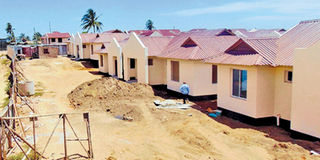Mortgage market growth slows: BoT

Residential units under construction in Kigamboni, Dar es Salaam. The Bank of Tanzania says the country’s mortgage market grew by six per cent last year, down from 16 per cent in 2016. PHOTO | FILE
What you need to know:
The annual growth rate in Tanzania last year was six per cent, down from 16 per cent in 2016, according to the latest Tanzania Mortgage Market update by the Bank of Tanzania (BoT).
Dar es Salaam. Growth of the mortgage market slowed down last year despite an increase in the number of players, a new report shows.
The annual growth rate in Tanzania last year was six per cent, down from 16 per cent in 2016, according to the latest Tanzania Mortgage Market update by the Bank of Tanzania (BoT).
“This slow growth was mainly on account of tight liquidity in the banking system,” the report says.
Lenders advanced a total of Sh344.84 billion towards residential housing last year, being a slight improvement from Sh324.08 billion that was issued in 2016.
On the other hand, the average mortgage debt size dropped last year, reaching Sh82.62 million from Sh93.6 million that was recorded in December 2016.
This was despite the fact that three new mortgage lenders joined the list of mortgaging firms in the country last year.
Letshego Bank (T) Limited, Yetu Microfinance Bank PLC and Mufindi Community Bank Ltd entered the fray to take to 31 the number of mortgage lenders in the country.
BoT expects the number of mortgage lenders to increase going forward, and this will intensify competition in the market.
The mortgage market was dominated by five top lenders in 2017. They accounted for 60 per cent of the market share, leaving 26 other players dividing the remaining 40 per cent among themselves.
Stanbic Bank Tanzania emerged as the leader with an 18 per cent slice of the mortgage market share.
It was followed by Bank M with 16 per cent, CRDB Bank (11 per cent), Azania Bank (8 per cent) and Commercial Bank of Africa (7 per cent).
“More positive developments are expected in the market with more banks now launching their mortgage loan products as competition in the traditional banking products continues to intensify,” the BoT report says.
Apart from the liquidity factor, the report adds that rising nonperforming loans (NPLs) were another cause for concern.
BoT figures show that as at end of April 2017, the ratio of NPLs to gross loans stood at 10.3 per cent from 8.2 per cent recorded at the end of April 2016.
Borrowers also had to contend with inadequate supply of affordable housing and high interest rates.
The situation, BoT says, might have been made complex with some bureaucratic processes around issuance of titles (especially unit titles). This poses a challenge by affecting borrowers’ eligibility to access mortgage loans.
In an attempt to boost private sector credit growth and ease tight liquidity, the report says, BoT reduced the discount lending rate from 16 per cent to 12 per cent in March 2017, and followed it with another reduction to 9 per cent in August 2017.




